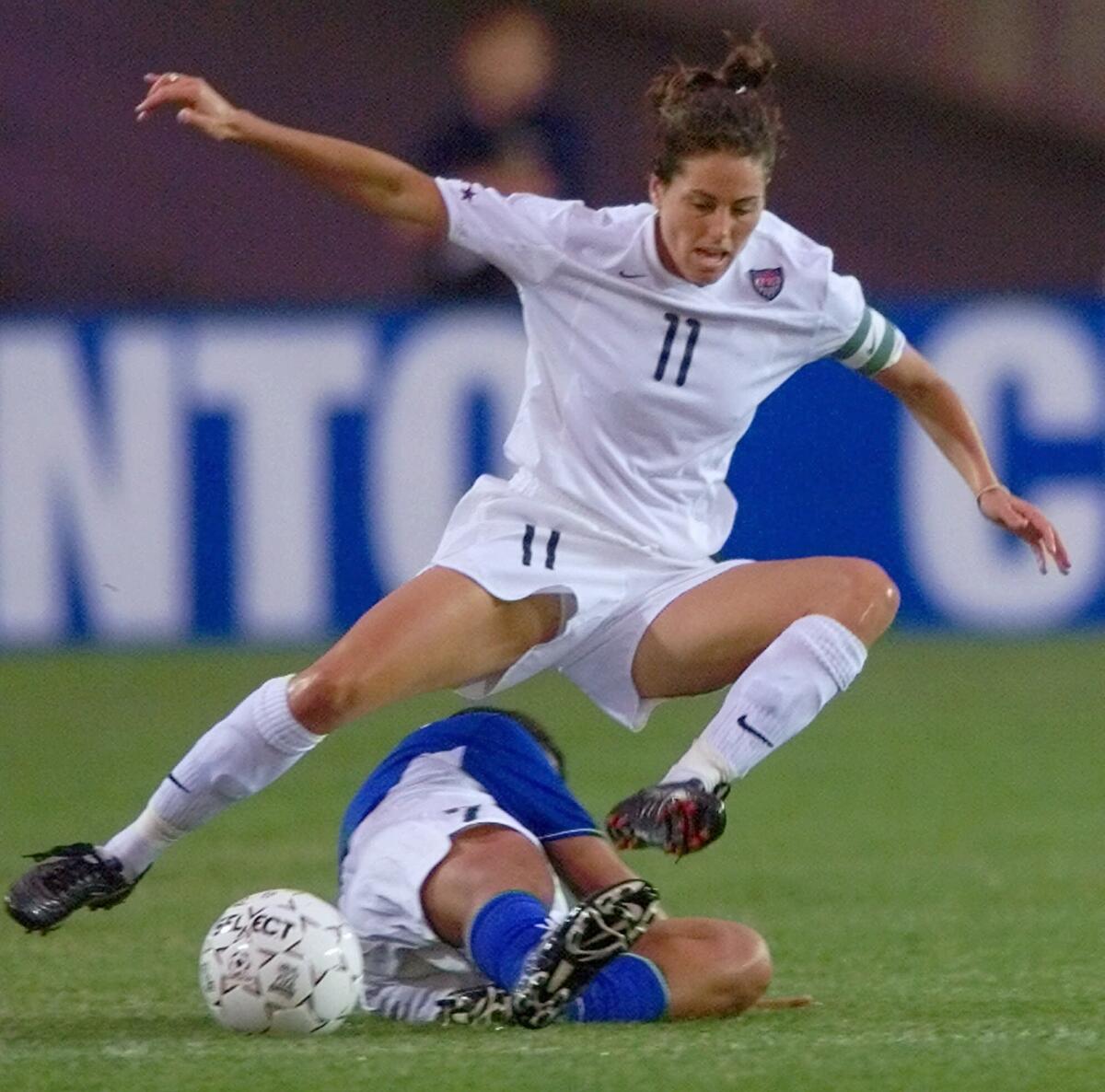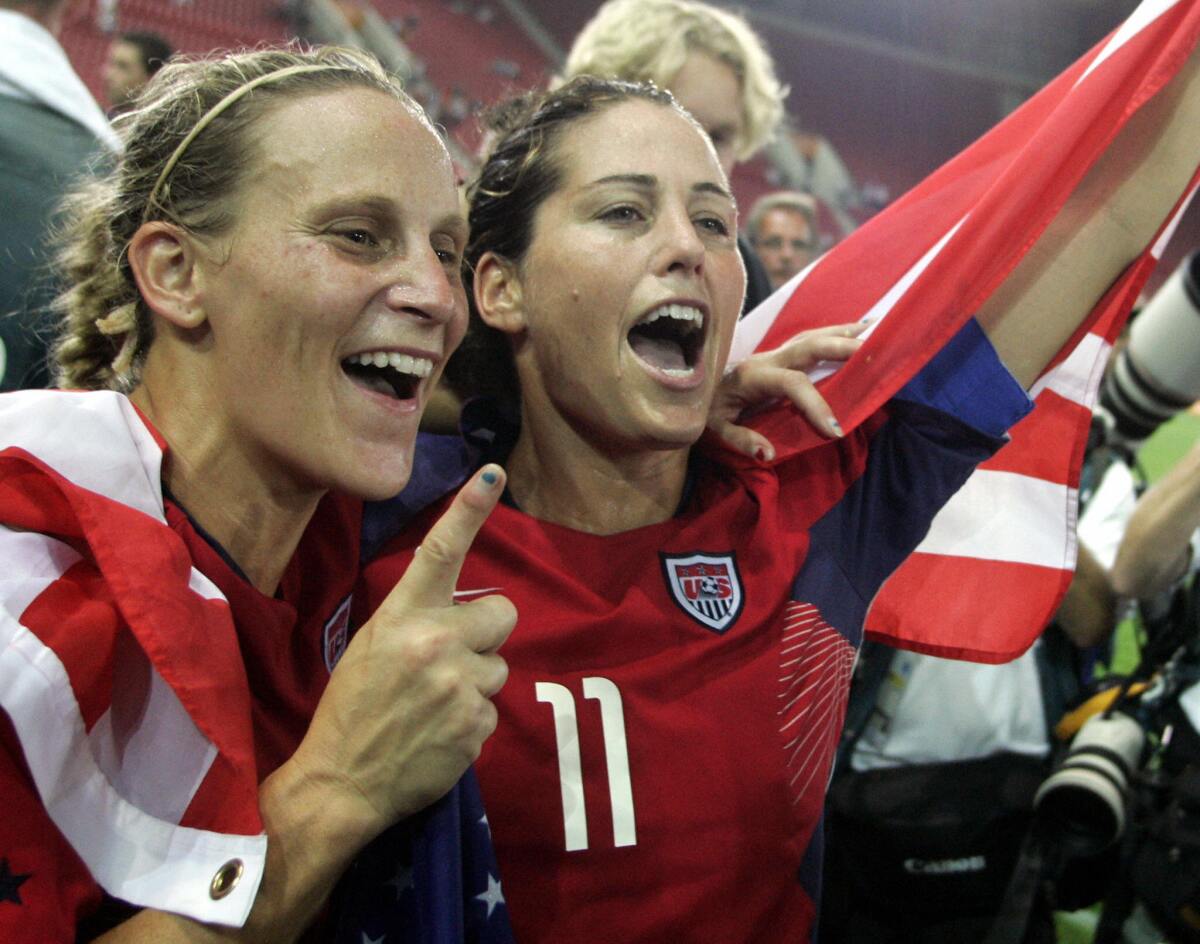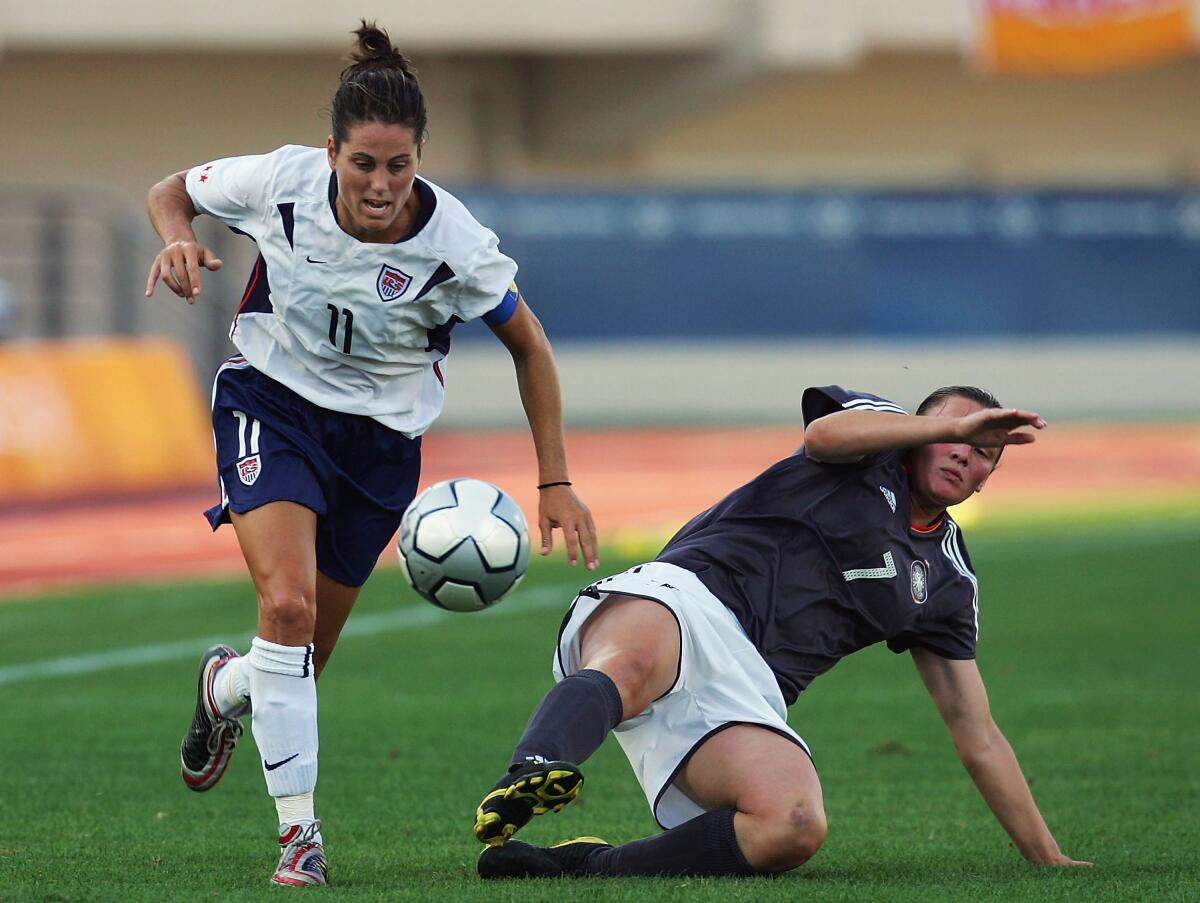Julie Foudy celebrates sisterhood as U.S. women’s national team departs for World Cup

- Share via
We waited our whole lives for this moment — the first Women’s World Cup to be held on American soil — and we wanted to set a standard, a benchmark for every World Cup to follow. We wanted big stadiums, a national footprint, large crowds, lots of buzz. The only question mark was kinda important: Could we fill the big stadiums? The players, of course, immediately thought “Oh hell, yes,” and a year in advance we had already set our sights. We hit the road, doing autograph sessions, clinics, appearances, any and all events to drive publicity and attention to our World Cup journey.
Cut to Nike headquarters in Portland, Oregon. Nike is staging the opening ceremony for their newest and largest building on their campus. The entire team was invited because the building bore a special dedication… It was the Mia Hamm Building. Which was mildly ironic, considering that if you were to look for Mia, the last place you’d find her was in the spotlight. Nevertheless, the rest of us were ecstatic that we got to celebrate our star teammate in such a singular moment. Knowing how much she “loved” the attention, we labeled every item in our hotel: The Mia Hamm Pillow, The Mia Hamm Door. You get the gist.
When Mia walked into the hotel and saw our handiwork she just shook her head and giggled.

That was our U.S. team. Equal parts intense and bat-s— silly. If the USWNT were a drink, I would say, mix one part fully committed into one part ridiculous and add a splash of nasty. When you understand that about us, you start to appreciate that our journey wasn’t just about the hardware. Yes, accolades are more than welcome because teams are typically measured in medals and championships. Legacies are often linked to titles. And we’ve collected quite a haul. This U.S. women’s team, over the course of its history dating back to the 1980’s, has won four World Cups and four Olympic Gold Medals for a total of eight world titles. That’s more than twice as many as the next closest country, Germany (but who’s counting?). So please don’t get me wrong — we love the bling, and winning has always been the goal for this team. It’s just never been the focus.
For generation after generation, the focus has always been on creating a family, competing our butts off, having fun, making our country proud and, equally important, thinking bigger than sports. The formula is pretty simple, really. Create and sustain a culture that values the we, the sisterhood, and the possible, treating the podium as not just a place to celebrate, but also a platform from which to holler for the world to up its game.
And holler we did. We never had a shortage of feisty women with great vocal chords, willing to use them. Maybe that should have been apparent way, way back in 1985 when the first USWNT to travel abroad did their pre-game cheer, straight from the soul: OOSA OOSA OOSA UHHHHHH. As the story goes, that’s how the fans in Jesolo, Italy, pronounced the name of our country, which they saw on the jerseys and the scoreboard. The U.S. players thought it was cool and made it our own. To this day, what started with that original team fittingly still roars out in the pregame huddle of every USWNT game.

Ahhh, the ‘80s, when the U.S. National team was formed, a glorious era with its wonderfully cringy trappings: big hair, mullets (Mia “business in the front, party in the back” Hamm), scrunchies (Carla Overbeck was the queen of these), Flashdance off-the-shoulder sweatshirts with a sports bra (looking at you, Brandi Chastain), VHS tapes to watch game film, Kristine Lilly’s yellow Sony Walkman cassette player, which I thought was perhaps the coolest thing I had ever seen. We were just a bunch of kids (literally: Mia was 15, I was 16 and Kristine Lilly was 16), incredibly grateful to be playing for our country, and completely clueless as to what that meant. There were no World Cups or Olympics for women’s soccer back in the 80s, although there had been for men’s soccer since the 1900 Olympics and the 1930 World Cup. Why, you ask? Because we were told it’s not what women do. Besides, people won’t come to see you play.
Well, as you can imagine, that didn’t go over well with this group of women. The USWNT players think people care about women’s soccer. Just you watch.
There was sufficient hollering by enough players and advocates of the women’s game for FIFA to say OK, OK, we will give you your World Cup, we are just not sure we will call it a World Cup yet. Hence the title: The M&M Mars Cup (I wish I was joking.) It was to be staged in China in the fall of 1991 and I remember telling my parents, “Mom! Dad! You are not going to believe it, we are finally going to get to play in our first Women’s World Cup, and it’s in China.” Now mind you, my parents were incredibly supportive of my soccer career but not exactly steeped in the hallowed history of the game. So maybe I shouldn’t have been surprised by my father’s reaction to the groundbreaking news: “Oh Julie, I am not sure I can make it, as that is a really busy time for me work-wise.”
“Dad, this is kinda a big deal,” I explained. “World Cups happen only once every four years. I may never make it to another. And this is the first ever for women. And you’re gonna be there, Dad.” I always giggle out loud when I think of that exchange. Imagine a parent of one of today’s players saying, Sorry honey, I don’t think I can make that World Cup, and what in the heck is a World Cup anyway?

Just goes to show you how much this game has grown here in the U.S. (or perhaps how oblivious my folks were). Part of me yearns for those early days of playing and the simplicity of it all. I remember never taking my cleats off after games as a wee lass. I’d wear them everywhere, until I wore the studs down to just stubs. I’m not sure of the exact day I fell under the spell of soccer, but the smell of fresh-cut grass, the laughter of a group of rad girls, and the freedom to compete without judgment had me at the first kick. We were just playing because it made our hearts happy, and it felt good. And that spell has been a strong, gorgeous one. I’ve either been playing the game, broadcasting the game, teaching the game or admiring the game my entire life.
But back to my folks. To be fair to Slim Jim and Fruity Judy, we never had women’s soccer role models back in the day. Nor did we have national teams or World Cups or Olympics to showcase them. As my friend and mentor Billie Jean King once pointed out to me, “We were the first generation in tennis, you all are the first gen in soccer. The first gens set all the standards and the culture.”
“They also go through all the s—,” I added, laughing. “But it is the s— that makes you great.” I really believe that. Perspective, the gift that keeps on giving. What I didn’t realize is that future generations would also have to overcome obstacles.
Whether it was for equitable treatment back in the ’90s or the more recent equal pay fight of this current team, we continue to holler while on top of podiums. Our goal is two-fold: to leave the game in a better place for the next generation and to be an inspiration for all seeking equal rights. That was a vital lesson I also learned from Billie Jean King when she said to me the first day I met her in the early 90s and we spoke about the lack of support for the women’s game: “Foudy, what are you as players doing about it? Speak up. Stand up. You have the power.” You’re damn right we do. And we made it our mission for the next generations to understand that as well. I’d say mission accomplished! This current group, as we all know, grabbed that baton and didn’t stop sprinting until they reached the historic legal settlement in which U.S. Soccer pledged equal compensation for its men’s and women’s teams going forward.
And that gets right to the heart of all I love and cherish about this USWNT year after year, decade after decade. We care deeply … about each other, about the game, about society, about being both inspirational and aspirational. The USWNT has spent its entire history making courage contagious. I could not be prouder to be a part of this amazing sisterhood. OK then, here we go, before our next adventure … give it from deep within your soul, all together now: OOSA OOSA OOSA UHHHH.
Julie Foudy is a Mission Viejo High alum and former Times high school player of the year who later won two World Cups and two Olympic gold medals. This essay was reprinted with permission from Pride of a Nation: A Celebration of the U.S. Women’s National Soccer Team. Text copyright © 2022 by David Hirshey, Rob Fleder, & Roger Director. Published by Ten Speed Press, a division of Penguin Random House, LLC.






